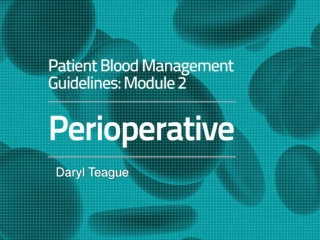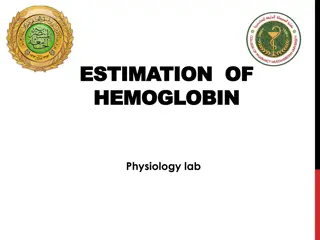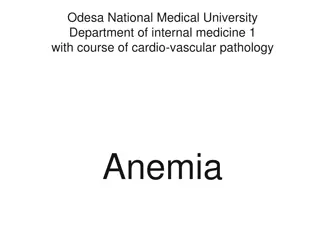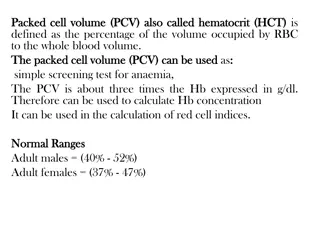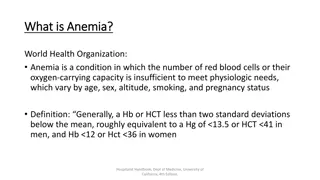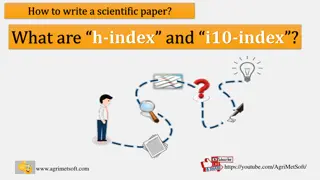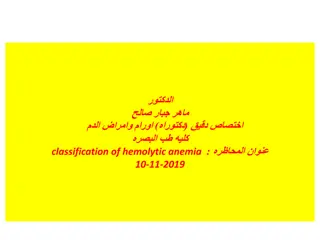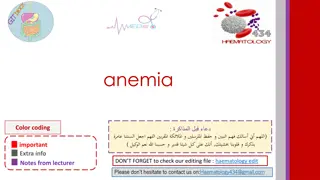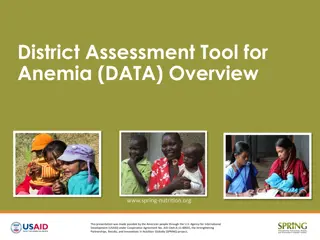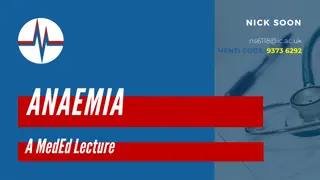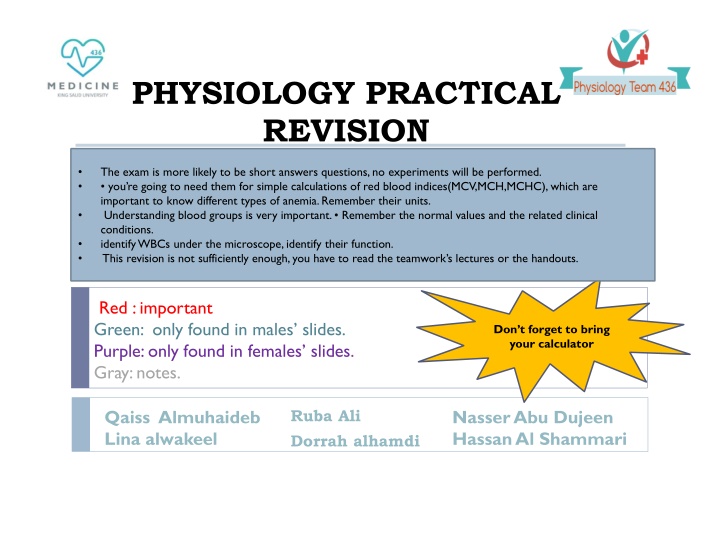
Simple Blood Index Calculations for Anemia Recognition
Prepare for a physiology practical exam focusing on blood indices, anemia types, and blood groups. Brush up on MCV, MCH, MCHC calculations, and understand the significance of WBC identification. Delve into abnormalities, causes, and clinical applications related to RBCs and hemoglobin. Enhance your knowledge on diagnosing anemia and other blood disorders for exam success.
Download Presentation

Please find below an Image/Link to download the presentation.
The content on the website is provided AS IS for your information and personal use only. It may not be sold, licensed, or shared on other websites without obtaining consent from the author. If you encounter any issues during the download, it is possible that the publisher has removed the file from their server.
You are allowed to download the files provided on this website for personal or commercial use, subject to the condition that they are used lawfully. All files are the property of their respective owners.
The content on the website is provided AS IS for your information and personal use only. It may not be sold, licensed, or shared on other websites without obtaining consent from the author.
E N D
Presentation Transcript
PHYSIOLOGY PRACTICAL REVISION The exam is more likely to be short answers questions, no experiments will be performed. you re going to need them for simple calculations of red blood indices(MCV,MCH,MCHC), which are important to know different types of anemia. Remember their units. Understanding blood groups is very important. Remember the normal values and the related clinical conditions. identify WBCs under the microscope, identify their function. This revision is not sufficiently enough, you have to read the teamwork s lectures or the handouts. Red : important Green: only found in males slides. Purple: only found in females slides. Gray: notes. Don t forget to bring your calculator Ruba Ali Dorrah alhamdi Qaiss Almuhaideb Lina alwakeel Nasser Abu Dujeen Hassan Al Shammari
In males slides: MCV is from 78-98 fl MCHC is from 32-36 Red Blood Indices (team work 435) Definition The calculation of Red Blood Indices Higher than average Average (normal value) Lower than average 77-98 m3 (fl) RBC are small in size and they are called Microcytes Cause : Iron deficiency RBC are large in size and they are called Macrocytes. Cause : Vit B12 or Folic deficiency Mean cell volume (MCV) The average volume of red blood cell measured in femtoliters (fl) ??? ?? ??? ????? MCV = PCV = packed cell volume RBCs Are Hypochromic Mean cell hemoglobin (MCH) The average weight of Hb in red blood cells cell measured in picograms (pg). RBCs are Hyperchromic 27-32 pg ?? ?? ??? ????? MCH = Hb = hemoglobin concentration Iron deficiency Anemia Concentration of Hb (hemoglobin) per 100 ml of RBC measured in grams/deciliters (g/dl). - 30-36 g/dl Mean cell Hb concentrati on (MCHC) MCHC = ?? ??? PCV = packed cell volume Hb=hemoglobin concentration ???
Example : An examination of the blood of 2 adult males (A and B) provided the following data: SUBJECT A SUBJECT B RBC COUNT 3.6 X 106 / mm3 2.5 X 106 / mm3 Hb Concentration 7.2 g/dl 8 g/dl Packed Cell Volume 25% 25% A) Calculate MCV, MCH and MCHC for each of these subjects. SUBJECT A SUBJECT B MCV = 25 x 10 /3.6 = 69.4 fl MCH = 7.2 x 10 / 3.6 = 20 pg MCHC = 7.2 x 100 / 25 = 28.8 g/dl MCV = 25 x 10 /2.5 = 100 fl MCH = 8 x 10 / 2.5 = 32 pg MCHC = 8 x 100 / 25 = 32 g/dl B) What are the abnormalities encountered in these men. What are the possible causes of these abnormalities?. Subject A Microcytic hypochromic anaemia (Iron deficiency anaemia) Subject B Macrocytic normochromic anaemia (Megaloblastic anaemia or Pernicious anaemia) Don t forget to bring your calculator
Normal value + Clinical applications: High number Low number o Low oxygen tension in the blood:(hypoxia) Congenital heart disease Cor pulmonale Pulmonary fibrosis o Dehydration (as : severe diarrhea). o Renal (kidney) disease with high erythropoietin production. o POLYCYTHEMIA: increase in RBCs no o Blood loss : due to : Anemia or Hemorrhage. o Bone marrow failure (exp: from radiation, toxin, fibrosis, tumor). o Erythropoietin deficiency (secondary to renal disease). o Hemolysis (RBC destruction). o ANAEMIA : Reduced ability of blood to carry Oxygen due to either decreased red blood cell count and/or haemoglobin concentration. RBCs Normal value : 4.7-5.6x 10^6/ l HB normal value : 13-18g/dl Called : Leukocytosis may indicate : Infectious diseases. Inflammatory disease (as : rheumatoid arthritis or allergy). Leukemia. Severe emotional or physical stress. Tissue damage (burns). called : Leukopenia may indicate Bone marrow failure (exp: due to infection, tumor or fibrosis). Presence of cytotoxic substance. Autoimmune/collagen-vascular diseases (as : lupus erythematosus). Disease of the liver or spleen. Radiation exposure. Leukocyte Normal value : 4-11x 10^3/ l Called : Thrombocytosis may indicate Chronic myeloid leukemia. Called : Thrombocytopenia may indicate : A plastic anemia. Chemotherapy. Platelets Normal value : 150-400x 10^3/ l Anemia (various types). Blood loss (hemorrhage). Bone marrow failure due to radiation, toxin, fibrosis, tumor). Hemolysis( RBC s destruction)related to transfusion reaction. Leukemia. Packed Cell Volume (PCV) or Hematocrit (35-54)% Dehydration : due to : Burns , Diarrhea Polycythemia Vera. Low oxygen tension due to : smoking , congenital heart disease, living at high altitudes *Plasma: has anticoagulants. *Serum: Without anticoagulants PCV : The ratio of packed blood cells volume to plasma (ratio of RBC s to plasma )
Erythrocyte Sedimentation Rate (ESR) ( ) ESR: Is the rate at which red blood cells sediment in a period of 1 hour. It is controlled by the balance between plasma protein (fibrinogen), and the negative charge of the erythrocytes. Normal ESR range : Normal ESR range : Male Male 3-5mm\1st hour , 7-15 mm\2nd hour Female slightly higher than 7 mm due to less RBC Female A very high ESR associated with : Moderately elevated ESR occurs : Infections, Inflammation , Anemia , Malignancies , Pregnancy , old age. multiple myeloma , polymyalgia Rheumatic , temporal arteritis Clinical application of ESR : C-reactive protein & ESR C-reactive protein is an acute phase protien produced by the liver during an inflammatory reaction. Since C-reactive protein levels in the blood rise more quickly after the inflammatory or infective process begins, ESR is often replaced with C-reactive protein measurement. Nonspecific test : a nonspecific marker of inflammation and is affected by other factors Prognostic not diagnostic. Monitor disease activity and response to therapy. ESR results must be used along with other clinical findings.
QUESTIONS AND PROBLEMS 1- What is the clinical importance of knowing the red blood cell indices? They help to determine the type of anemia a patient is suffering from. 2- Discuss briefly the etiological classification of Anemia? TYPES OF ANEMIA CAUSE Hemorrhagic Anemia Loss of blood Aplastic Anemia Bone marrow suppression by drugs or radiations etc. Hemolytic Anemia Increased destruction of RBCs such as sickle cell disease Macrocytic normochromic anemia Megaloblastic anemia : Deficiency of folic acid, Vitamin B12 Nutritional Anemia Pernicious anemia : Malabsorption of Vit 12 due to lacking of intrinsic factor in the stomach Microcytic Hypochromic anemia Deficiency of Iron Microcytic Hypochromic non- nutritional anemia Thalassemia 3- What is meant by rouleaux formation? When red blood cells are stacked together in long chains because of their biconcave disc like surfaces sticking to each other, it is called Rouleaux formation. 4- Why does rapid rouleaux formation increase the E.S.R.? Rouleaux formation becomes rapid when plasma protein concentration is high and because of this E.S.R. also becomes increased.
Never Let Monkey Eat Banana Neutrophil , Lymphocyte , Monocyte , Eosinophil , Basophil Most common less common WBC Differential Leukocyte Count (DLC) ? a routine test in hospitals which determine the percentage of each type of white blood cells in the total leucocyte population. granules contain Heparin (an anticoagulant). and Histamine, which increases the permeability of capillary walls. Stains are used: 1. Leishman s stain 2. Wright s stain The diagram above from 435
Blood Groups and Rhesus system Blood Groups and Rhesus system Antigen is what makes these blood types different ; they re the cells identification tag Rh is misnomer and it refers to the presence or absence of the D antigen on the red blood cell there is D (+) , No D (-) AB + : universal receiver O- : universal donor Agglutination : Ag A + Anti A = positive reaction Agglutination : Ag B + Anti B = positive reaction No clumping : no ag A /B = negative reaction The most common form is ABO incompatibility, which is usually not very severe. The least common form is Rh incompatibility O+ is the most common in Saudi Arabia AB- least common in Saudi Arabia
Clinical Applications Clinical Applications Important in the following condition : Clotting Time Bleeding Time Hemolytic disease of the new born (HDN) (Erythroblasto sis Fetal) Blood product It is rough measure of all intrinsic clotting factors (monitoring anti-coagulant therapy) It is The time taking for bleeding to stop (time for a platelet plug to form). Blood transfusion Time : 2-7 in glass tube : 5-15 2-5min (some says 2-7) HDN It is a blood disorder in a fetus or newborn infant when a mother and her unborn baby have different blood types (called "incompatibility"). Mother produces antibodies to Rh (D) antigen. after the labor because the mother s blood will be mixed with baby s blood , So the Antibody will attack the developing baby's red blood cells (2nd baby with Rh+ ) Prevention : mother is given (Rhogam) anti-D antibodies after birth of Rh positive baby (After 1st baby) Treatment of baby with incompatibility : Mild : Drugs used to treat allergic reactions (antihistamines) Drugs used to treat swelling and allergies (steroids) Feeding and fluids (hydration) Fluids given through a vein (intravenously) Light therapy using bilirubin lights Medicines to raise blood pressure if it drops too low Sever : exchange transfusion after birth or intrauterine transfusion before birth Clotting time is used in : Used : in diagnosis of hemophilia. Clinical significance of the clotting time: Before surgery , Diagnosis of bleeding disorders prolong the bleeding time: due to Platelet dysfunction. Blood vessel wall disorders. Von Willebrand Disease. Thrombocytopenia. Vitamin K deficiency. Medications such as : Aspirin. Mother is Rh- father is Rh+ (Rh+ is more dominant ) : baby is RH+

